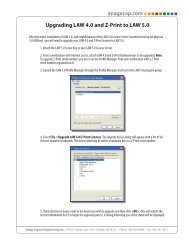Getting Started Guide - LexisNexis
Getting Started Guide - LexisNexis
Getting Started Guide - LexisNexis
You also want an ePaper? Increase the reach of your titles
YUMPU automatically turns print PDFs into web optimized ePapers that Google loves.
GETTING STARTED GUIDE I LAW PREDISCOVERY <br />
n Root Folder: If a root folder value is specified here, the file type(s) (images, native and/or full text) are<br />
placed in the following folder structure: \. For example, if a Text root folder is<br />
specified for the Full Text file type, and the specified export path is C:\Exports\EDD_001\vol001, then the<br />
full text will be placed in C:\Exports\EDD_001\vol001\Text. The Folder Naming scheme (see next option)<br />
will be applied following the Root Folder.<br />
n Folder Naming: Three options exist for folder naming, as shown below. You can apply one option to all by<br />
selecting an option as the Default. Or use the Override setting and choose different options for each.<br />
Custom uses 1 to 3 of the specified index fields to create a folder structure when exporting<br />
(see Files/Folder option below).<br />
Mirror Original mirrors the current structure, as shown in the folder tree in the main<br />
interface of LAW PreDiscovery.<br />
Incremental places the specified number of files in a 001 folder, then creates a 002 folder,<br />
and so on (see Files/Folder option below).<br />
n Files/Folder: This column applies only to the Incremental and Custom folder naming schemes.<br />
If Incremental was chosen, enter the desired number of files to be placed in each folder or use<br />
the default of 250. If Custom was chosen, use this field to launch the Custom Folder Structure<br />
dialog box and choose the field or fields containing the folder structure.<br />
CHAPTER 8<br />
66



